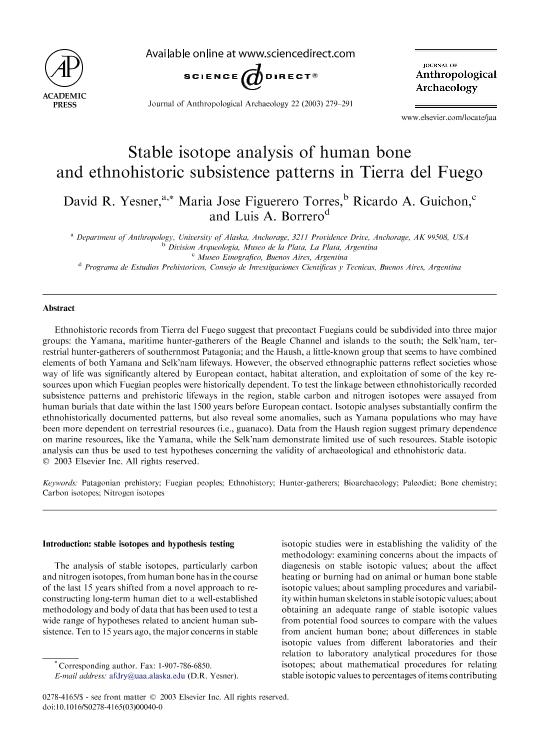Mostrar el registro sencillo del ítem
dc.contributor.author
Yesner, David
dc.contributor.author
Figuerero Torres, María José
dc.contributor.author
Guichon, Ricardo
dc.contributor.author
Borrero, Luis Alberto

dc.coverage.spatial
Tierra del Fuego, Argentina
dc.date.available
2018-01-23T14:19:30Z
dc.date.issued
2003-12
dc.identifier.citation
Yesner, David; Figuerero Torres, María José; Guichon, Ricardo; Borrero, Luis Alberto; Stable isotope analysis of human bone and ethnohistoric subsistence patterns in Tierra del Fuego; Elsevier; Journal of Anthropological Archaeology; 22; 12-2003; 279-291
dc.identifier.issn
0278-4165
dc.identifier.uri
http://hdl.handle.net/11336/34251
dc.description.abstract
Ethnohistoric records from Tierra del Fuego suggest that precontact Fuegians could be subdivided into three major groups: the Yamana, maritime hunter-gatherers of the Beagle Channel and islands to the south; the Selk’nam, terrestrial hunter-gatherers of southernmost Patagonia; and the Haush, a little-known group that seems to have combined elements of both Yamana and Selk’nam lifeways. However, the observed ethnographic patterns reflect societies whose way of life was significantly altered by European contact, habitat alteration, and exploitation of some of the key resources upon which Fuegian peoples were historically dependent. To test the linkage between ethnohistorically recorded subsistence patterns and prehistoric lifeways in the region, stable carbon and nitrogen isotopes were assayed from human burials that date within the last 1500 years before European contact. Isotopic analyses substantially confirm the ethnohistorically documented patterns, but also reveal some anomalies, such as Yamana populations who may have been more dependent on terrestrial resources (i.e., guanaco). Data from the Haush region suggest primary dependence on marine resources, like the Yamana, while the Selk’nam demonstrate limited use of such resources. Stable isotopic analysis can thus be used to test hypotheses concerning the validity of archaeological and ethnohistoric data.
dc.format
application/pdf
dc.language.iso
eng
dc.publisher
Elsevier
dc.rights
info:eu-repo/semantics/openAccess
dc.rights.uri
https://creativecommons.org/licenses/by-nc-sa/2.5/ar/
dc.subject
Stable Isotopes
dc.subject
Tierra del Fuego
dc.subject
Ethnohistory
dc.subject
Archaeology
dc.subject.classification
Otras Sociología

dc.subject.classification
Sociología

dc.subject.classification
CIENCIAS SOCIALES

dc.title
Stable isotope analysis of human bone and ethnohistoric subsistence patterns in Tierra del Fuego
dc.type
info:eu-repo/semantics/article
dc.type
info:ar-repo/semantics/artículo
dc.type
info:eu-repo/semantics/publishedVersion
dc.date.updated
2017-11-24T14:27:43Z
dc.journal.number
22
dc.journal.pagination
279-291
dc.journal.pais
Estados Unidos

dc.journal.ciudad
New York
dc.description.fil
Fil: Yesner, David. University Of Alaska; Estados Unidos
dc.description.fil
Fil: Figuerero Torres, María José. Universidad Nacional de La Plata. Facultad de Ciencias Naturales y Museo; Argentina
dc.description.fil
Fil: Guichon, Ricardo. Universidad de Buenos Aires. Facultad de Filosofía y Letras. Museo Etnográfico "Juan B. Ambrosetti"; Argentina
dc.description.fil
Fil: Borrero, Luis Alberto. Consejo Nacional de Investigaciones Científicas y Técnicas. Oficina de Coordinación Administrativa Saavedra 15. Instituto Multidisciplinario de Historia y Ciencias Humanas; Argentina
dc.journal.title
Journal of Anthropological Archaeology
dc.relation.alternativeid
info:eu-repo/semantics/altIdentifier/url/https://www.sciencedirect.com/science/article/pii/S0278416503000400
dc.relation.alternativeid
info:eu-repo/semantics/altIdentifier/doi/http://dx.doi.org/10.1016/S0278-4165(03)00040-0
Archivos asociados
